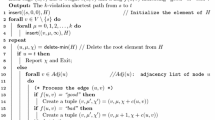Abstract
A classical problem of geometry is the following: given a convex polygon in the plane, find an inscribed polygon of shortest circumference. In this paper we generalize this problem to arbitrary polygonal paths in space and consider two cases: in the “open” case the wanted path of shortest length can have different start and end point, whereas in the “closed” case these two points must coincide. We show that finding such shortest paths can be reduced to finding a shortest path in a planar “channel”. The latter problem can be solved by an algorithm of linear-time complexity in the open as well in the closed case. Finally, we deal with constrained problems where the wanted path has to fulfill additional properties; in particular, if it has to pass straight through a further point, we show that the length of such a constrained polygonal path is a strictly convex function of some angle α, and we derive an algorithm for determining such constrained polygonal paths efficiently.
Zusammenfassung
Ein klassisches Problem der Geometrie fragt nach einem einbeschriebenen Polygon kürzesten Umfanges eines gegebenen konvexen Polygons. Wir verallgemeinern dieses Problem auf beliebige Polygonzüge im Raum und untersuchen zwei Fälle: im “offenen” Fall kann der gesuchte Streckenzug kürzester Länge einen unterschiedlichen Anfangs- und Endpunkt haben, während im “geschlossenen” Fall diese beiden Punkte zusammenfallen müssen. Es wird gezeigt, daß solche kürzesten Polygonzüge durch kürzeste Streckenzüge in einem ebenen “Kanal” bestimmt werden, die in beiden Fällen durch einen Algorithmus mit linearer Laufzeit bestimmt werden können. Ferner wird der Fall behandelt, daß der gesuchte Polygonzug ohne Knick durch einen vorgegebenen Punkt gehen soll. Es wird gezeigt, daß die Länge des Polygonzuges dann eine streng konvexe Funktion eines bestimmten Winkels ist, wodurch es möglich wird, auch dieses Problem effizient zu lösen.
Similar content being viewed by others
Explore related subjects
Discover the latest articles, news and stories from top researchers in related subjects.References
H. Alt and E. Welzl (1988): Visibility graphs and obstacle avoiding shortest paths. Zeitschrift für Operations Research32 145–164.
W. P. Chin and S. Ntafos (1988): Optimum watchman routes, Inf. Proc. Letters28 39–44
J. Focke (1986): A finite descent method for Steiner's problem of inpolygons with minimal circumference. Optimization17, 355–366
S. Gao, M. Jerrum, M. Kaufmann, K. Mehlhorn, W. Rülling and C. Storb (1988a): On continuous homotopic one layer routing, Proc. Fourth Annual Symp. Computational Geometry, Urbana-champaign, pp. 392–402.
S. Gao, M. Jerrum, M. Kaufmann, K. Mehlhorn, W. Rülling and C. Storb (1988b): On continuous homotopic one layer routing (extended abstract), in: H. Noltemeier (ed.), Computational Geometry and its Applications, Proc. CG'88, International Workshop on Computational Geometry, Würzburg, FRG, March 1988, Lecture Notes in Computer Science333, Springer-Verlag, pp. 55–70.
L. Guibas, J. Hershberger, D. Leven, M. Sharir and R. E. Tarjan (1987), Linear time algorithms for visibility and shortest path problems inside triangulated simple polygons, Algorithmica2, 209–233.
L. Guibas, J. Hershberger, D. Leven, M. Sharir and R. E. Tarjan (1986), Linear time algorithms for visibility and shortest path problems inside simple polygons, Proc. Second Annual Symp. Computational Geometry, pp. 1–13.
R. Klötzler and H. Rudolph (1985): Zur analytischen und algorithmischen Behandlung eines geometrischen Optimierungsproblems von J. Steiner, Optimization16, 833–848
D. T. Lee and F. P. Preparata (1985): Euclidean shortest paths in the presence of rectilinear barriers Networks14, 393–410.
J. S. B. Mitchell, D. M. Mount and C. H. Papadimitriou (1987): The discrete geodesic problem, SIAM J. Comput.16, 647–668
H. X. Phù (1987): Ein konstruktives Lösungsverfahren für das Problem des Inpolygons kleinsten Umfanges von J. Steiner, Optimization18, 349–359.
H. A. Schwarz (1890): Gesammelte Mathematische Abhandlungen, Band 2, Berlin, pp. 344–345.
M. Sharir and A. Schorr (1986): On shortest paths in polyhedral spaces. SIAM J. Comput.15, 193–215
J. Steiner (1882): Gesammelte Werke, Band 2, Berlin, p. 45.
R. Sturm (1884): Bemerkungen und Ansätze zu Steiners Aufsätzen über Maxima und Minima. Journal für reine und angew. Math.96, 36–77
M. Tompa (1981): An optimal solution to a wire-routing problem, Journal of Computer and Systems Sciences23, 127–150.
Author information
Authors and Affiliations
Rights and permissions
About this article
Cite this article
Burkard, R.E., Rote, G., Yao, E.Y. et al. Shortest polygonal paths in space. Computing 45, 51–68 (1990). https://doi.org/10.1007/BF02250584
Received:
Revised:
Issue Date:
DOI: https://doi.org/10.1007/BF02250584




